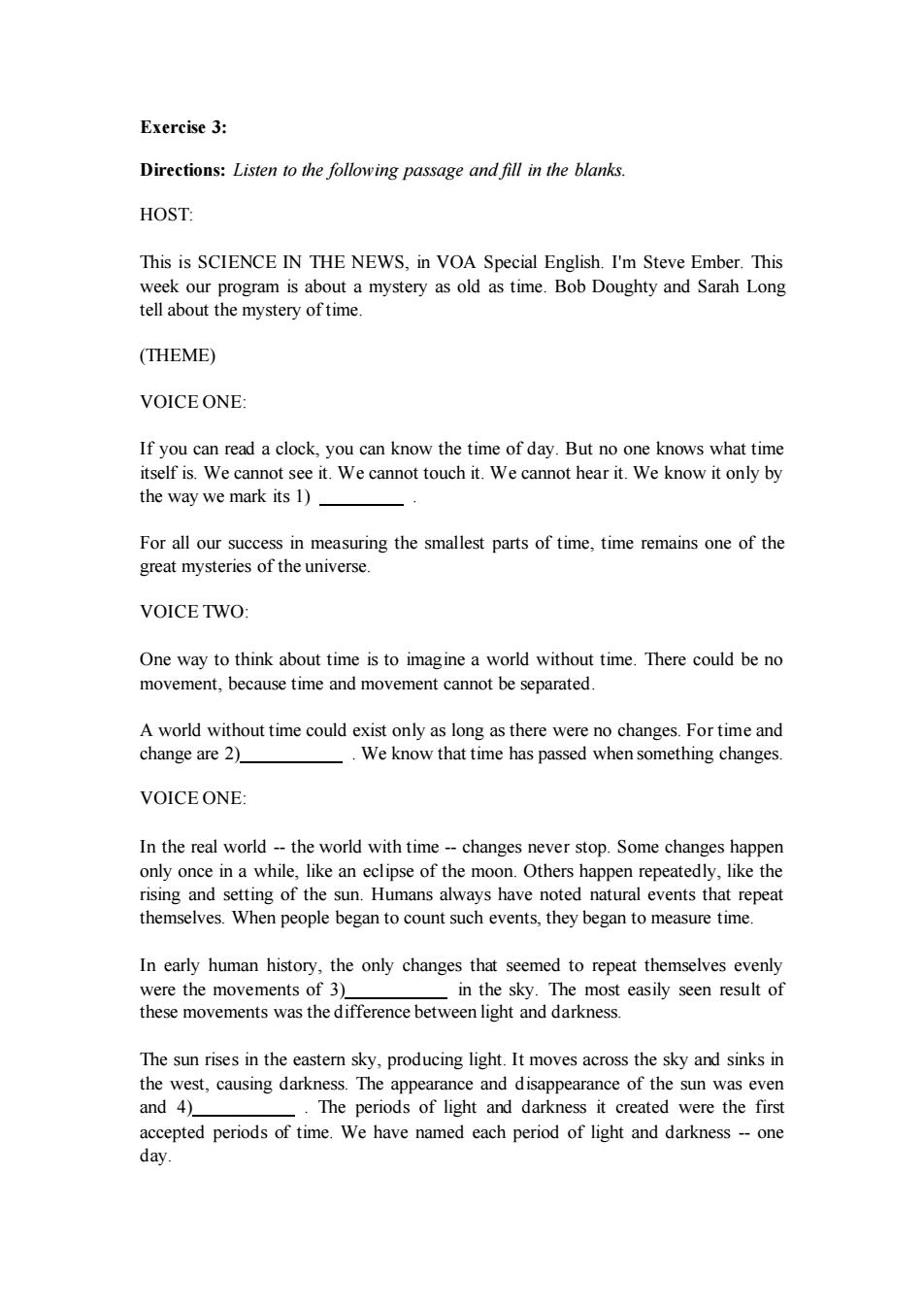正在加载图片...

Exercise 3: Directions:Listen to the following passage and fill in the blanks. HOST: This is SCIENCE IN THE NEWS,in VOA Special English.I'm Steve Ember.This week our program is about a mystery as old as time.Bob Doughty and Sarah Long tell about the mystery of time. (THEME) VOICE ONE: If you can read a clock,you can know the time of day.But no one knows what time itself is.We cannot see it.We cannot touch it.We cannot hear it.We know it only by the way we mark its 1) For all our success in measuring the smallest parts of time,time remains one of the great mysteries of the universe. VOICE TWO: One way to think about time is to imagine a world without time.There could be no movement,because time and movement cannot be separated. A world without time could exist only as long as there were no changes.For time and change are 2) _We know that time has passed when something changes. VOICE ONE: In the real world--the world with time--changes never stop.Some changes happen only once in a while,like an eclipse of the moon.Others happen repeatedly,like the rising and setting of the sun.Humans always have noted natural events that repeat themselves.When people began to count such events,they began to measure time. In early human history,the only changes that seemed to repeat themselves evenly were the movements of 3) in the sky.The most easily seen result of these movements was the difference between light and darkness. The sun rises in the eastern sky,producing light.It moves across the sky and sinks in the west,causing darkness.The appearance and disappearance of the sun was even and 4) _The periods of light and darkness it created were the first accepted periods of time.We have named each period of light and darkness --one day.Exercise 3: Directions: Listen to the following passage and fill in the blanks. HOST: This is SCIENCE IN THE NEWS, in VOA Special English. I'm Steve Ember. This week our program is about a mystery as old as time. Bob Doughty and Sarah Long tell about the mystery of time. (THEME) VOICE ONE: If you can read a clock, you can know the time of day. But no one knows what time itself is. We cannot see it. We cannot touch it. We cannot hear it. We know it only by the way we mark its 1) . For all our success in measuring the smallest parts of time, time remains one of the great mysteries of the universe. VOICE TWO: One way to think about time is to imagine a world without time. There could be no movement, because time and movement cannot be separated. A world without time could exist only as long as there were no changes. For time and change are 2) . We know that time has passed when something changes. VOICE ONE: In the real world -- the world with time -- changes never stop. Some changes happen only once in a while, like an eclipse of the moon. Others happen repeatedly, like the rising and setting of the sun. Humans always have noted natural events that repeat themselves. When people began to count such events, they began to measure time. In early human history, the only changes that seemed to repeat themselves evenly were the movements of 3) in the sky. The most easily seen result of these movements was the difference between light and darkness. The sun rises in the eastern sky, producing light. It moves across the sky and sinks in the west, causing darkness. The appearance and disappearance of the sun was even and 4) . The periods of light and darkness it created were the first accepted periods of time. We have named each period of light and darkness -- one day